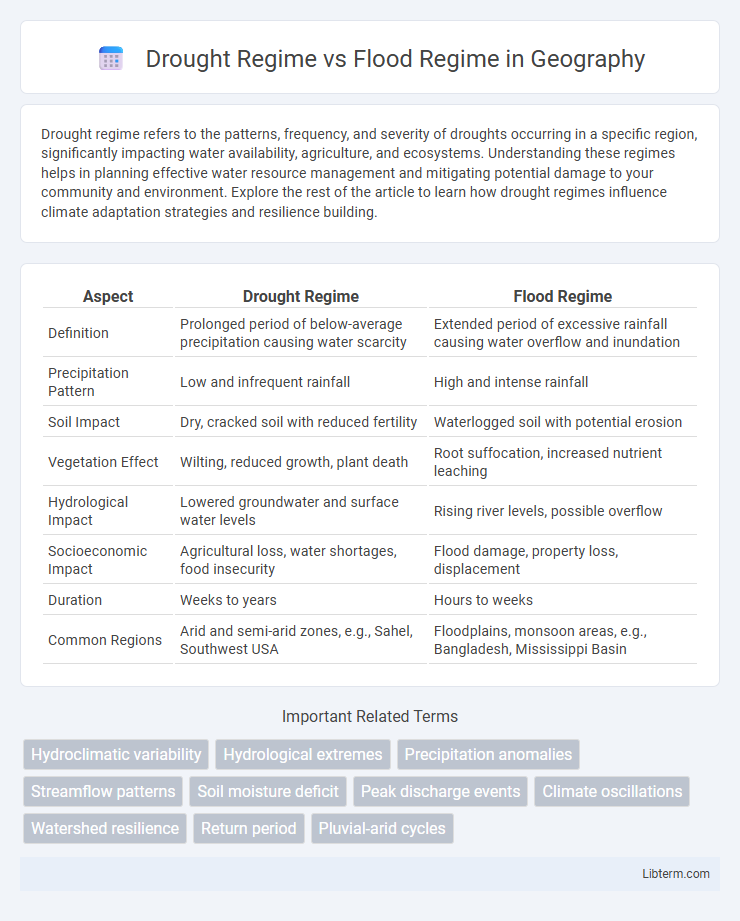Drought regime refers to the patterns, frequency, and severity of droughts occurring in a specific region, significantly impacting water availability, agriculture, and ecosystems. Understanding these regimes helps in planning effective water resource management and mitigating potential damage to your community and environment. Explore the rest of the article to learn how drought regimes influence climate adaptation strategies and resilience building.
Table of Comparison
| Aspect | Drought Regime | Flood Regime |
|---|---|---|
| Definition | Prolonged period of below-average precipitation causing water scarcity | Extended period of excessive rainfall causing water overflow and inundation |
| Precipitation Pattern | Low and infrequent rainfall | High and intense rainfall |
| Soil Impact | Dry, cracked soil with reduced fertility | Waterlogged soil with potential erosion |
| Vegetation Effect | Wilting, reduced growth, plant death | Root suffocation, increased nutrient leaching |
| Hydrological Impact | Lowered groundwater and surface water levels | Rising river levels, possible overflow |
| Socioeconomic Impact | Agricultural loss, water shortages, food insecurity | Flood damage, property loss, displacement |
| Duration | Weeks to years | Hours to weeks |
| Common Regions | Arid and semi-arid zones, e.g., Sahel, Southwest USA | Floodplains, monsoon areas, e.g., Bangladesh, Mississippi Basin |
Understanding Drought Regime and Flood Regime
Drought regime refers to extended periods of below-average precipitation leading to water scarcity, reduced soil moisture, and impacts on agriculture and ecosystems. Flood regime involves frequent or intense precipitation events causing river overflow, soil saturation, and damage to infrastructure and habitats. Understanding these regimes helps in managing water resources, disaster preparedness, and climate adaptation strategies.
Key Differences Between Drought and Flood Regimes
Drought regimes are characterized by prolonged periods of below-average precipitation leading to water scarcity, reduced soil moisture, and stressed ecosystems, while flood regimes involve excessive rainfall or rapid snowmelt causing river overflow, inundation, and soil erosion. Key differences include the temporal scale, with droughts developing gradually over months or years versus floods occurring rapidly over hours or days. Impact variations also exist; droughts primarily compromise water supply and agricultural productivity, whereas floods mainly cause property damage, loss of life, and landscape alteration.
Causes and Drivers of Drought Regime
Drought regimes are primarily caused by prolonged periods of below-average precipitation, high temperatures, and increased evapotranspiration, often driven by climatic patterns such as El Nino-Southern Oscillation and shifting atmospheric circulation. Land-use changes, deforestation, and water mismanagement exacerbate drought severity by reducing soil moisture retention and groundwater recharge. Understanding natural variability and anthropogenic influences is essential for predicting drought onset and mitigating impacts in vulnerable regions.
Triggers and Mechanisms of Flood Regime
Flood regimes are primarily triggered by extreme precipitation events, rapid snowmelt, or storm surges, which cause sudden increases in river discharge and water levels. The mechanisms involve overwhelmed drainage systems, soil saturation, and reduced infiltration capacity, leading to surface runoff accumulation and widespread inundation. Topography, land use, and river channel characteristics further influence the magnitude and duration of flooding within a flood regime.
Impacts of Drought Regimes on Ecosystems
Drought regimes cause prolonged water scarcity, reducing soil moisture and stressing vegetation, which leads to decreased plant growth and biodiversity loss. Aquatic ecosystems suffer from lowered water levels, disrupting habitats and causing declines in fish and amphibian populations. These changes alter food webs and ecosystem services, potentially triggering long-term ecosystem degradation.
Flood Regimes: Ecological and Social Consequences
Flood regimes, characterized by frequent or intense water overflow events, profoundly impact aquatic and terrestrial ecosystems by reshaping habitats, altering nutrient cycles, and influencing species distribution and population dynamics. Socially, flood regimes can cause displacement, infrastructure damage, and economic losses, while also creating opportunities for fertile agriculture in floodplains and replenishing groundwater resources. Effective flood management integrates ecological conservation with community resilience strategies to mitigate adverse outcomes and harness flood benefits.
Adaptation and Mitigation Strategies for Drought
Adaptation strategies for drought regimes emphasize water conservation techniques, sustainable agricultural practices, and development of drought-resistant crop varieties to enhance resilience. Mitigation efforts include efficient water management systems, such as rainwater harvesting and groundwater recharge, to reduce the severity of drought impacts. Implementing early warning systems and climate-smart policies also supports proactive responses, minimizing socioeconomic disruptions in drought-prone regions.
Managing Risks in Flood-Prone Areas
Effective management of risks in flood-prone areas requires understanding the contrasting characteristics of drought and flood regimes, including their seasonal variability and intensity patterns. Implementing integrated water resource management strategies, such as constructing levees, floodways, and retention basins, can mitigate flood impacts while ensuring water availability during drought conditions. Employing advanced hydrological modeling and early warning systems enhances preparedness and response capabilities, reducing socioeconomic vulnerabilities in flood-prone regions.
Climate Change Influences on Hydrological Regimes
Climate change intensifies drought regimes by reducing precipitation and increasing evapotranspiration, leading to prolonged water deficits and soil moisture depletion. Flood regimes are exacerbated through heightened rainfall intensity and frequency, causing more severe and frequent flash floods and riverine flooding events. Shifts in hydrological patterns disrupt ecosystem balance, water resource management, and agricultural productivity worldwide.
Building Resilient Communities: Lessons from Extremes
Drought regimes and flood regimes represent two distinct hydrological extremes that challenge community resilience by disrupting water availability and safety. Building resilient communities involves integrating adaptive water management strategies, early warning systems, and infrastructure designed to withstand these extremes. Lessons from past drought and flood events emphasize the importance of community engagement, diversified water sources, and sustainable land use planning to mitigate impacts and enhance recovery.
Drought Regime Infographic

 libterm.com
libterm.com